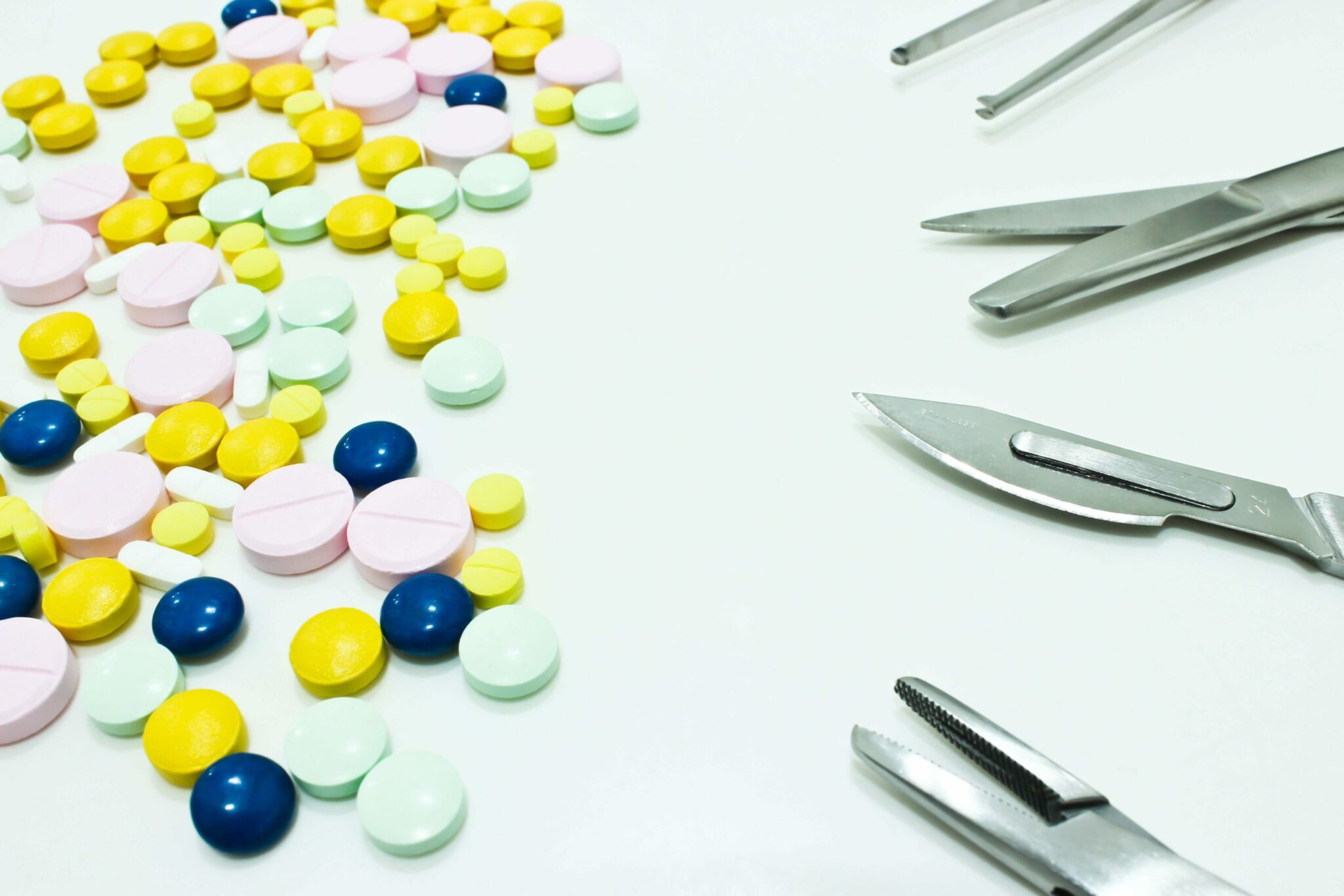Treating Fibroids


Fibroids are non-cancerous growths that develop around the uterus. Many women experience no symptoms and do not require any intervention. Fibroids often shrink during the menopause when symptoms ease or cease completely. However, for the 30-40% of women who are symptomatic during their reproductive years, implementing a suitable treatment plan is essential.
One of the most common symptoms is painful, heavy periods. Reducing any heavy bleeding is important not only because it can negatively impact a woman’s quality of life, but also because excessive blood loss can cause other medical issues, such as anaemia.
Treatment will typically be tailored to an individual patient depending on her specific symptoms. Medications, surgical procedures and non-surgical procedures are the main treatment options.
Medication
The most common symptoms of fibroids are heavy periods and pelvic pain and, whilst the cause for most women remains unknown, the hormone oestrogen seems to play a role. Evidence for this comes from the fact that symptoms usually appear for the first time during a female’s reproductive years, when oestrogen levels are high, and disappear during the menopause when oestrogen levels naturally decline. As a result of this association, hormonal contraceptives are often one of the first-line treatment options for managing the heavy bleeding and period pain seen with fibroids. The combined oral contraceptive pill and the progestin-only mini pill are frequently used, with the latter having fewer adverse side effects. The combined pill contains syntheitic versions of the hormones oestrogen and progesterone (oestradial and progestin); it prevents ovulation and makes periods lighter and less painful. Artificial progestogen suppresses the growth of endometrial tissue, again making periods lighter and reducing inflammation and pain in the area. Progestin (synthetic progesterone) can also be given as an injection or via the levonorgestrel intrauterine system (also known as the Mirena coil). The continual release of progestin from the Mirena coil prevents the lining of the uterus from getting too thick, making periods lighter and, sometimes, stopping them altogether. These therapies are not suitable for those who are seeking help for infertility.
Tranexamic acid therapy is another option to reduce heavy bleeding. It is an anti-fibrinolytic drug (prevents blood loss by promoting blood clotting) that is given during menstruation and can reduce bleeding by 35-60%. This therapy is useful for those women who are attempting to conceive. Side effects include gastrointestinal discomfort and nausea and this drug should not be used by those who have a family history of blood clots. If symptoms do not improve after 2-3 menstrual cycles, use should be discontinued.
Non-steroidal Anti-inflammatory drugs (NSAIDs) reduce pain and inhibit the production of prostaglandins. Prostaglandins cause the uterus to contract during menstruation and this contributes to period pain. These drugs are less effective at reducing blood loss, but due to their wide availability, they are a good first line approach to control the pain associated with fibroids.
Gonadotrophin releasing hormone agonists (GnRHs) work by targeting the pituitary gland. The pituitary gland is part of an intricate feedback system that results in synthesis of the two major female sex hormones (oestrogen and progesterone). The binding of GnRHs to a receptor in the pituitary gland, suppresses ovarian follicle development, reduces oestrogen secretion and causes atrophy of the endometrium (uterus lining). The net result is lighter periods, reduced pain and fibroid shrinkage. The downside to this treatment is that it can cause menopausal-like side effects, including vaginal atrophy, hot flushes and bone loss; so its use is often supplemented with low dose hormone replacement therapy (HRT). The detrimental side effects mean that GnRHs are normally only prescribed for a short period of time, often to shrink fibroids prior to surgery.
Ulipristal acetate is an alternative option for reducing heavy periods and shrinking fibroids, although it is generally only used to treat moderate-severe symptoms. It acts on the progesterone receptors in the uterus, inhibiting ovulation without affecting oestrogen levels. This means that the side effects associated with reduced oestrogen levels, including hot flushes and bone loss are not seen and concurrent hormonal therapy is not required. At a dose of 5mg, uterine bleeding was controlled in over 90% of cases and fibroid volume was significantly reduced. Ulipristal acetate has an alternative use as a form of emergency contraception, although as it hinders ovulation, it will only prevent pregnancy if taken prior to this. The use of this drug for this purpose may deter certain people from using it, due to the negative connotations associated with emergency contraception. Currently, ulipristal acetate is only prescribed for short time periods, usually prior to surgical intervention. However, the limited side effects and restoration of fertility upon completion of treatment suggest that this drug might become more widely used in the future.
Surgery
Between 30 and 50% of all hysterectomies are performed because of fibroid-related issues. However, with the advent of newer, more intricate techniques, fewer women are having to take such an extreme approach.
A hysterectomy involves surgical removal of the uterus. It is the most definitive way of ‘curing’ fibroids. However, it is not suitable for women who still hope to have children. The preferred approach is to remove the uterus via the vagina, due to shorter surgical time and reduced blood loss; but in cases where the fibroids are large, the uterus may need to be removed via a cut in the abdomen. Having a hysterectomy can cause a woman to enter an immediate menopause, with the associated side effects of hot flushes, reduced libido, depression and bone loss. Thus, supplementary treatment with HRT may be required.
An alternative surgical option, which does not leave a woman infertile, is to perform a myomectomy. The optimal approach is to use keyhole surgery (laparoscopy), although if necessary a larger, ‘open’ cut across the abdomen will be made. It is only suitable for certain types of fibroids, namely those that are submucosal (project into the uterus) in origin. The recurrence/regrowth rate following this type of surgery is 15-33%.
Hysteroscopic techniques involve excising the fibroids via the vagina. A hysteroscope (thin telescope) is inserted first and then the affected tissue is cut away. Once again, there is a chance of regrowth, but this may be a suitable technique for those with smaller fibroids who want to maintain their fertility.
Non-surgical Procedures
Non-surgical techniques include Uterine Artery Embolisation (UAE). This involves injecting blocking agents into the uterine arteries, which limit blood supply to the uterus and fibroids. The recovery period is less than with surgical procedures; however, data on the impact of UAE on future fertility is inconclusive. Within 5 years, 20-33% of patients will require further surgical treatment.
Another non-surgical procedure is endometrial ablation is where the lining of the uterus (the endometrium) is removed using heat, lasers, radiowaves or electrosurgery. This technique can only be performed on women with a normal sized uterus and fibroids <3cm in diameter. Recovery times are reduced, compared to conventional surgical techniques, however, the endometrium can grow back over time and the procedure is not recommended for women who wish to have children in the future as it carries a high risk of subsequent miscarriage.
A third, non-surgical treatment approach is myolysis, which is a conservative technique whereby the fibroids and/or their blood supply are directly targeted for destruction by heat, laser, ultrasound or cryotherapy. This treatment may permanently alter the integrity of the endometrium, so future pregnancies are not advised. One of the most recent approaches is magnetic-resonance-guided focused ultrasound surgery (MRgFUS), which in comparison to other myolysis techniques is more effective and less invasive. An MRI is used to guide ultrasound energy, which then destroys the fibroids. When compared to hysterectomy, it produced a similar quality of life score six months after treatment, but with significantly fewer complications.
Unfortunately no perfect treatment is currently available. A hysterectomy is generally considered the technique most likely to give permanent relief; however, it also causes irreversible infertility, menopausal symptoms and is a major procedure to undergo. With many of the more conservative surgical procedures, reformation of the fibroids over time is common. Furthermore, those medications that interrupt steroid hormone synthesis, whilst effective in the short term, are restricted in their use by significant side effects.
Taking a careful, well thought out approach to fibroid treatment is important. The emphasis should be symptom reduction, taking into account the age and future fertility of the patient.
Having observed and learnt that, try Nabta’s women’s health test to learn more on fibroids.
Nabta is reshaping women’s healthcare. We support women with their personal health journeys, from everyday wellbeing to the uniquely female experiences of fertility, pregnancy, and menopause.
Get in touch if you have any questions about this article or any aspect of women’s health. We’re here for you.
Sources:
- De La Cruz, M S, and E M Buchanan. “Uterine Fibroids: Diagnosis and Treatment.” American Family Physician, vol. 95, no. 2, 15 Jan. 2017, pp. 100–107.
- Donnez, J, et al. “Ulipristal Acetate versus Placebo for Fibroid Treatment before Surgery.” New England Journal of Medicine, vol. 366, no. 5, 2 Feb. 2012, pp. 409–420., doi:10.1056/NEJMoa1103182.
- Singh, S S, and L Belland. “Contemporary Management of Uterine Fibroids: Focus on Emerging Medical Treatments.” Curent Medical Research and Opinion, vol. 31, no. 1, Jan. 2015, pp. 1–12., doi:10.1185/03007995.2014.982246.
- Sriprasert, I, et al. “Heavy Menstrual Bleeding Diagnosis and Medical Management.” Contraception and Reproductive Medicine, vol. 2, 24 July 2017, p. 20., doi:10.1186/s40834-017-0047-4.
- Stewart, E A. “Uterine Fibroids.” Lancet, vol. 357, no. 9252, 27 Jan. 2001, pp. 293–298., doi:10.1016/S0140-6736(00)03622-9.
- Stewart, E A, et al. “Uterine Fibroids.” Nature Reviews Disease Primers, vol. 2, no. 16043, 23 June 2016, doi:10.1038/nrdp.2016.43.
- “Fibroids: Treatment.” NHS, www.nhs.uk/conditions/fibroids/treatment/. Page last reviewed: 17/09/2018.












































